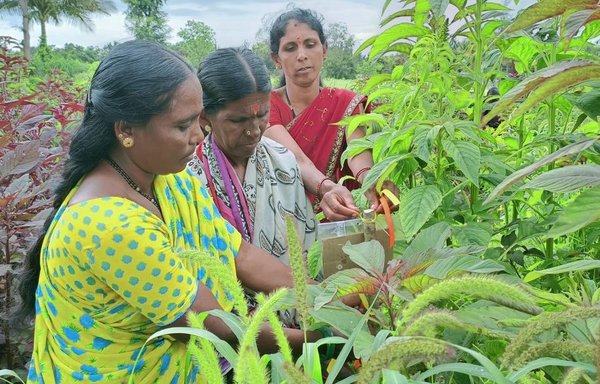 Read this article in French
Read this article in French- Share this article
- Subscribe to our newsletter
Swiss development organisations promoting more diversity in fields
Today, 42 per cent of calorie consumption world-wide is provided by just three plant species: wheat, rice and maize.
In contrast, traditional and hardy plant species, such as the nutrient-rich and drought-tolerant amaranth plant, have largely been ousted from the markets over the last few years.
Launched in 2021, the CROPS4HD project seeks to address this shortcoming. The abbreviation stands for 'Consumption of Resilient Orphan Crops & Products for Healthier Diets', and the aim is to improve livelihoods by promoting the use and conservation of traditional, neglected seed varieties. Unlike commercial crops, traditional varieties are often highly nutritious, drought-tolerant and pest-resistant.
Farming families involved right from the start
"Many smallholder families in India are well aware of the traditional plants, but no longer use them," says Tanay Joshi, a research scientist and project coordinator at the Research Institute of Organic Agriculture (FiBL) in Frick, Switzerland, which is responsible for implementing the project in partnership with the NGO Swissaid and the Alliance for Food Sovereignty in Africa (AFSA).
CROPS4HD is co-funded by the Swiss Development Cooperation (SDC) and is currently being carried out in Niger, Chad, Tanzania and India.
Tanay Joshi, who heads the research project in India and Tanzania, sees two main problems: the lack of seed availability and of market access. "The cultivation of traditional varieties still isn't getting the attention it deserves, from either the public or the private sector," says Joshi, pointing out that there is no steady demand, no purchase guarantee and no fixed market price. "For smallholder families, this means a big risk."
In order to minimise that risk, the project operates at three levels. First, it procures seeds from various actors, makes them available to farmers and provides them with training in agroecological practices. Second, it aims to raise consumer awareness of these products and boost demand. Third, it works towards progress in policy-making that will enable traditional varieties to be integrated into the formal seed system, thus increasing market opportunities.
Community seed banks are also to be strengthened to make it easier for farmers to acquire the seeds. "The farming families should be involved in the project right from the start," says Joshi.
One vehicle for achieving this is known as participatory variety selection, where varieties are tested in the fields. Here, the first step is for participants to define the most important criteria that a variety must meet. Examples include durability, yield, or size and texture of the leaves.
"The aim is to identify the varieties that are preferred by most farmers," explains Joshi, who supervised an experiment of this kind on a farm in the state of Karnataka in southwest India last September. "This way, the choice of variety is adapted to their needs, not the other way around."
"Not the best time for experiments"
In parallel with the training sessions for the farming families, the project also hopes to create new markets. The plan is to open six markets in three states – West Bengal, Odisha and Karnataka – where producers can sell their agroecological products directly to consumers.
“It's not so easy to win farmers over to the idea,” says Pramod Pradhan, who oversees the project in India on behalf of Swissaid. Climate change is becoming more and more noticeable in India, which has currently been experiencing record rainfall for months – rainfall that is destroying crops and transport routes. "It's not the best time for experiments," Pradhan states.
This makes networking among the farming families important. It enables the new cultivation methods and traditional varieties to be circulated more efficiently, helps simplify transport to the markets and allows the costs, of organic certification for example, to be shared. Six of these farmers' cooperatives are currently being planned as part of the project.
"Ultimately, boosting consumer confidence in the products is essential," says Pradhan. CROPS4HD therefore promotes events designed to encourage the required exchange. Among other things, these include visits to farming families to learn about their cultivation methods. But seed festivals, cooking competitions and recipe books also form part of the campaign. In the larger cities, attempts are made to bring the smallholder farmers together with wholefood shops. After all, everything is connected. "The more people become aware of the nutritional value and diversity of edible plants, the more these will be cultivated by farmers."
Author: Samanta Siegfried, free journalist, Basel Switzerland
This article was taken from the magazine « One World », Edition: 01/2023
More information :





Add a comment
Comments :